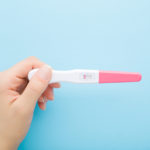About Fertility
What Tests Are Involved With an Infertility Evaluation?

One of the first steps of diagnostic testing of infertility is an evaluation of the uterine cavity. Often patients ask what tests are involved with an infertility evaluation? Knowing what to expect with an HSG, SHG, or hysteroscopy and how they differ is helpful to ease any anxiety.
Implantation and the Start of Pregnancy
The uterus, fallopian tubes and cervix work independently and in concert. In natural conception the egg is scooped up by the fronds of the fallopian tube and gently is propelled from the outer tube toward the entrance of the uterine cavity. Egg and sperm meet in the tube where fertilization can take place.
This now created embryo continues toward the uterine entrance way as it is dividing. Again, it is propelled by the wave-like motions of the fallopian tube muscles. A whole new world exists for this embryo upon entering the uterus from the fallopian tube passageway. The readied uterine-cavity is akin to the nooks and crannies of an English muffin. The embryo continues to roll for another day, and continues its development; it is now a hatching blastocyst in search of a home. The endometrial glands of the uterus have been busy preparing themselves equally. The blastocyst then latches on to the endometrium at the precise moment that the endometrium allows such latching. This process is called implantation. The embryo burrows itself into the endometrium to create new blood vessels and start the formation of this entirely new organ called the placenta.
What Tests Are Involved for an Infertility Evaluation?
Our diagnostic tests that look at the uterus examine these precise steps.
- Hysterosalpingogram (HSG)
Using radiography, dye is introduced through the cervix into the uterine cavity and it is anticipated to spill out of the tubes and into the abdominal cavity. This test tells us if the inside of the uterus and tubes appear to have a normal structure and if the tubes are open. It cannot tell us about the outside of the uterus. It can tell us if the fallopian tubes are swollen (hydrosalpinx) but it cannot tell us how well they function or if the egg and sperm can meet. - Sonohysterogram (SHG)
Using saline, fluid is introduced in the same way as the HSG above. Ultrasound can be used to visualize the inside of the uterine cavity and in conjunction with the uterine structure. It cannot see the fallopian tubes well (unless they are swollen). One cannot see the fluid leave the fallopian tubes but we can use bubbles to track the path and note if we see fluid in the abdominal cavity after the procedure, know that it came from one of the tubes. It cannot necessarily predict if both tubes are patent (open) or just one. - Hysteroscopy (office or operating room)
It provides great visualization of the inside of the uterine cavity, and allows subtle findings that may not be noted on HSG or possibly SHG to be defined and often corrected. It does not visualize the fallopian tubes or their track. - Diagnostic Laparasopy/Hysterosopy
It is old-school and allows direct visualization of both. Dye can be entered into the cervix and in real-time, its path through the tubes and into the cavity can be visualized. It is a bit much for such an assessment and is surgery. Risk-benefit ratio here is often skewed to the risk part. - Endometrial biopsy/Scratch Test
Endometrial biopsy can accurately define pathology (95% accurate) which is excellent for questions regarding potential cancerous findings. It can be used to look for endometritis (inflammation), but unnecessary for everyone. The scratch test simply is a biopsy in hopes that implantation would be promoted in subsequent cycles. It is not particularly useful. - Endometrial Timing
The landmark academic paper is from 1950s which detailed cellular changes in an endometrial biopsy noted as seen throughout the menstrual cycle after a. Advanced for 1950s and replaced by the ERA, endometrial receptivity assay, which, in itself harbors controversy with some. It defines the precise “window of implantation” which can be replicated in a frozen embryo transfer cycle (requires IVF) when the exact parameters are indeed, replicated.
Where To Start With Fertility Treatment
At the Fertility Centers of New England, we’re committed to helping you create a healthy family by providing the individualized expertise you need and the compassionate support you deserve. If you have more questions on how to get started with reciprocal IVF, contact us today to schedule your initial consultation.


